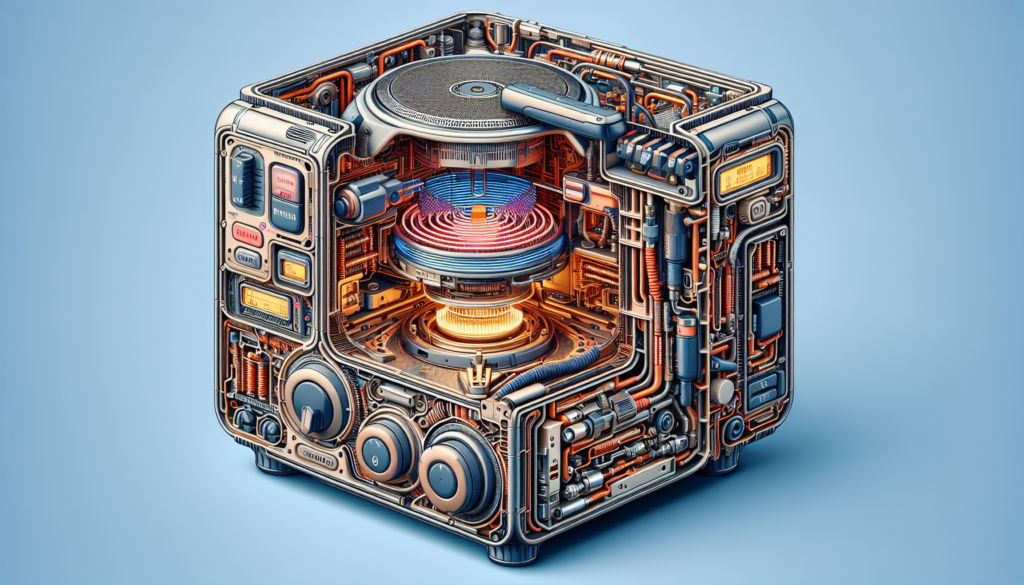Electric portable stoves are revolutionizing the way we cook on the go. Designed to bring convenience and versatility to any outdoor adventure or small space, these portable gems offer a simple solution for cooking without the need for a traditional gas stove. But how do they actually work? By utilizing electricity, these compact stoves generate heat through a heating element, allowing you to cook your favorite meals wherever you go. Offering a friendly and reliable cooking experience, electric portable stoves are a game-changer for anyone seeking culinary independence outside the confines of a standard kitchen.

CHECK OUT COUNTERTOP BURNERS ON AMAZON
Overview of Electric Portable Stoves
Definition of Electric Portable Stoves
Electric portable stoves are compact cooking appliances that utilize electricity to generate heat for cooking food. These stoves are designed to be portable, allowing users to cook their favorite meals wherever they go. Whether you’re on a camping trip, in a dorm room, or simply need an extra cooking surface for your kitchen, electric portable stoves can be the perfect solution.
Advantages of Electric Portable Stoves
Electric portable stoves come with a multitude of advantages. Firstly, they offer convenience and flexibility. With their compact size and portability, you can take them with you on your outdoor adventures, use them in small spaces, or even bring them to potluck parties. Additionally, electric portable stoves heat up quickly and tend to have a more consistent and precise temperature control compared to their gas counterparts. They are easy to clean and maintain, making them a practical choice for busy individuals or those living in smaller living spaces. Lastly, electric portable stoves are energy-efficient, helping you save on energy costs while minimizing their impact on the environment.
Components of Electric Portable Stoves
Heating Element
At the heart of every electric portable stove lies the heating element. This element is responsible for converting electrical energy into heat, allowing you to cook your meals. The heating element can be either a coil or an induction plate, depending on the type of electric portable stove you choose.
Thermostat
The thermostat is an essential component in electric portable stoves as it regulates the temperature. It ensures that the stove maintains a consistent level of heat during the cooking process. By accurately monitoring and adjusting the temperature, the thermostat helps prevent overcooking or undercooking of your food.
Power Source
Electric portable stoves require an electrical power source to operate. Most models can be plugged directly into a standard wall outlet using a power cord. Some advanced models may even offer additional power options such as USB or battery-powered capabilities, providing further convenience and portability.
Control Knobs
Control knobs are used to adjust the temperature settings of the electric portable stove. By turning the knobs, you can increase or decrease the heat output to achieve the desired level for your cooking needs. The control knobs are typically located on the front of the stove and are designed to be easy to use and understand.
Indicator Lights
Indicator lights are small, light-emitting diodes (LEDs) that provide feedback on the status of the electric portable stove. These lights can indicate when the stove is powered on, when it has reached the desired temperature, or when it is ready for use. Indicator lights add a level of convenience and safety, ensuring that you are aware of the stove’s operating status at all times.
Types of Electric Portable Stoves
Coil Burner Stoves
Coil burner stoves are one of the most common types of electric portable stoves. They feature coil-shaped heating elements made of high-resistance materials such as stainless steel. When the electric current passes through the coil, it generates heat, which is transferred to the cookware placed on top. Coil burner stoves are known for their affordability, durability, and versatility. They can accommodate various cookware sizes and shapes, making them suitable for a wide range of cooking tasks.
Induction Stoves
Induction stoves have gained popularity in recent years due to their innovative technology and energy efficiency. Unlike coil burner stoves, induction stoves utilize magnetic fields to generate heat directly in the cookware itself. The induction coil beneath the glass cooktop produces an alternating electromagnetic field. When a compatible cookware, such as stainless steel or cast iron, is placed on the cooktop, the magnetic field induces electrical currents within the cookware, generating heat. Induction stoves provide precise temperature control, faster heating times, and increased safety, as the cooktop remains cool to the touch.

CHECK OUT COUNTERTOP BURNERS ON AMAZON
Working Principle of Electric Portable Stoves
Electricity Conversion into Heat
The working principle of electric portable stoves revolves around electricity conversion into heat. When the stove is connected to a power source and turned on, an electric current flows through the heating element. This electric current encounters resistance within the heating element, causing it to heat up and generate thermal energy.
Heating Element Activation
Once the heating element reaches the desired temperature, the thermostat within the stove regulates its activation. The thermostat uses sensors to measure the temperature and adjust the flow of electricity accordingly. If the temperature drops below the set level, the thermostat reactivates the heating element to maintain a consistent level of heat.
Electricity Conversion into Heat
Passing Electric Current
To convert electricity into heat, electric portable stoves rely on the passage of an electric current through a conductor. The heating element acts as the conductor, allowing the electric current to flow through it. As the current passes through the heating element, it encounters resistance, which leads to the generation of heat. The level of resistance determines the amount of heat produced, and this can be adjusted using the control knobs on the stove.
Resistance Heating
Electric portable stoves utilize a heating element made of materials with high electrical resistance, such as nichrome wire or stainless steel. These materials are chosen for their ability to generate heat efficiently when an electric current flows through them. The high resistance of the materials causes them to heat up quickly and provide consistent heat distribution across the cooking surface.
Heating Element Activation
Thermostat Regulation
To ensure that the electric portable stove maintains a steady temperature during cooking, a thermostat is incorporated into the design. The thermostat continuously monitors the temperature of the heating element and activates or deactivates it based on the desired temperature setting. By regulating the heat output, the thermostat helps prevent food from burning or being undercooked, ensuring optimal cooking results.
Coil Burner Stoves
Description and Working Mechanism of Coil Burner Stoves
Coil burner stoves consist of one or multiple coil-shaped heating elements on the cooking surface. When the stove is turned on and electricity is supplied, the current passes through the coils, causing them to heat up. The heat is then transferred to the cookware placed on top of the coils, allowing the food to be cooked. The coil burner stoves are often equipped with multiple burners, providing users with the flexibility to cook multiple dishes simultaneously at different heat levels.
Pros and Cons of Coil Burner Stoves
Coil burner stoves offer several advantages. They are affordable, making them accessible to a wide range of consumers. They are also durable and can withstand heavy-duty cooking tasks. Additionally, coil burner stoves can accommodate various cookware sizes and styles, making them versatile for different cooking needs.
However, coil burner stoves also have some limitations. They can be slower to heat up compared to induction stoves and may have less precise temperature control. The exposed coils can make the cleaning process more challenging, as food particles can easily get trapped between the coils. Despite these limitations, coil burner stoves remain a popular choice for many individuals due to their affordability and versatility.
Induction Stoves
Description and Working Mechanism of Induction Stoves
Induction stoves employ advanced magnetic induction technology to heat the cookware directly. The stovetop surface remains cool to the touch during cooking as the heat is generated within the cookware itself. When an induction-compatible cookware is placed on the stovetop, the magnetic field induces electrical currents within the cookware, generating heat. This allows for precise and efficient cooking, as the heat is focused directly on the cookware and not wasted on heating the surrounding air.
Pros and Cons of Induction Stoves
Induction stoves offer numerous advantages. They provide fast heating times, which means your food can be cooked more quickly compared to other types of stoves. The precise temperature control allows for greater culinary precision, enabling you to achieve consistent and professional-level results. Induction stoves also offer increased energy efficiency, as they heat up and cool down faster than traditional stoves. Additionally, the cool stovetop surface reduces the risk of burns and makes cleaning up spills easier.
Despite their advantages, induction stoves may require the use of specific cookware made with magnetic materials. This can limit your choice of cookware and potentially add to the overall cost. Induction stoves also tend to have a higher initial purchase price compared to coil burner stoves. Nevertheless, with their modern features and energy-efficient operation, induction stoves are becoming increasingly popular among home cooks and culinary enthusiasts.
Advancements in Electric Portable Stoves
Smart Features
Advancements in technology have led to the integration of smart features into electric portable stoves. These features can vary from stove to stove but often include programmable timers, digital displays, and even wireless connectivity. With the help of smartphone applications and voice control assistants, you can remotely control and monitor your cooking process. Smart features add a level of convenience and customization to your cooking experience, allowing you to have greater control over your meals.
Energy Efficiency
Electric portable stoves have seen improvements in energy efficiency over the years. Manufacturers have developed more efficient heating elements and implemented advanced heat distribution systems to minimize energy loss. By utilizing the latest technology, electric portable stoves can deliver optimal heat transfer to the cookware while consuming less power. These energy-efficient designs help you save on electricity bills and contribute to a greener, more sustainable lifestyle.
Safety Enhancements
Safety is a top priority when it comes to electric portable stoves. Manufacturers have introduced various safety enhancements to ensure the well-being of users. These may include overheating protection, auto shut-off features, and child lock functions. Overheating protection systems prevent the stove from reaching dangerous temperatures, reducing the risk of accidents or fires. Auto shut-off features automatically turn off the stove after a specific period of inactivity, providing peace of mind and preventing energy wastage. Child lock functions are designed to prevent accidental activation of the stove by curious little hands, ensuring a safe cooking environment for families with young children.
Maintenance and Safety Tips
Cleaning and Care
To maintain the performance and longevity of your electric portable stove, regular cleaning and care are essential. Always allow the stove to cool down completely before cleaning. Wipe the stovetop surface with a damp cloth or sponge and mild dish soap to remove any spills or stains. Avoid using abrasive cleaners or scrub brushes that may damage the surface. For coil burner stoves, remove the heating coils when necessary and clean them separately to prevent the accumulation of food debris. It is also important to check and clean the control knobs and indicator lights regularly to ensure proper functionality.
Safe Usage Guidelines
To ensure safe usage of your electric portable stove, follow these guidelines:
- Always read and follow the manufacturer’s instructions and safety guidelines provided with the stove.
- Place the stove on a stable and heat-resistant surface away from flammable materials.
- Avoid overcrowding the surface with cookware to prevent overheating and uneven cooking.
- Use cookware that is compatible with the stove’s specifications, especially for induction stoves.
- Keep an eye on the stove while cooking and never leave it unattended.
- Disconnect the stove from the power source when not in use and before cleaning.
- Be cautious of the hot surfaces and handles to avoid burns.
- Unplug the stove during electrical storms to prevent potential damage from power surges.
By following these maintenance and safety tips, you can ensure a safe and enjoyable cooking experience with your electric portable stove.
